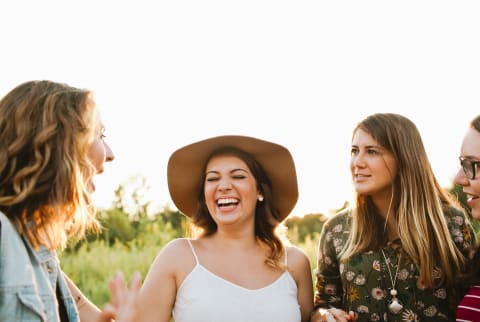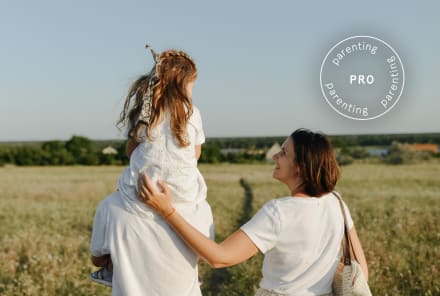Advertisement
How To Spot Your "Core Circle" & Why It's Essential For Fulfilling Friendships


Friendship is such a unique phenomenon; unlike so many relationships in our lives, we choose our friends. We are so afraid of being on the out side, though; we so much want to belong, to be part of an in-group, to avoid ever having to be alone with ourselves, that we can be, well, less than discriminating when it comes to whom we choose.
Social media, with its emphasis on follower count, only worsens this impulse. (And don’t get me started on how grotesque its transformation of “friends” into “followers” is to begin with.)
The more the better, right? Wrong. We might believe we’re cultivating a lush, beautiful karmic garden, but the reality is that most of our gardens are overrun with weeds and have unwanted root systems to pull: friendships that are depleting us, enabling harmful behaviors, or reflecting versions of ourselves we have already outgrown.
Realistically, a single person can care for a "garden" of only limited size
That’s why the Huntington Gardens here in LA or the Keukenhof in Amsterdam or the Tivoli Gardens outside Rome— just pick any incredible, huge garden you can think of—are manned by crews, not a lone dude with a rake.
It’s counterintuitive, but many of us need fewer friends. Fewer, better friends. Closer friends. We need to focus on our inner circle and be intentional about our relationships.
Evolutionary psychologist Robin Dunbar is known for “Dunbar’s number,” the maximum amount of stable relationships an individual can cognitively manage. That number is 150—but it includes all your relationships: your family, your lovers, your friends, even your professional relationships.
Dunbar visualizes those relation ships as a series of four concentric circles, each ring indicating greater intimacy as it moves toward the center. The outer ring, which com prises all 150 people, is the “weddings and funeral” layer—the people who would show up for that once-in-a-lifetime event. The next ring comprises fifty people, the housewarming crew, the big birthday-party bash.
The next ring of fifteen represents our core social circle, the people we know well and trust enough to watch our kids in a pinch.
The last ring is made up of your core five relationships, the people who will drop everything when you really need them, the people you turn to at times of deepest sorrow and most profound joy, the people who—at least most of the time—make you feel seen for who you are and love you unconditionally. The ones you can call when you’re gripped with guilt and regret and remorse, who will listen without judgment. Whose hand you’d want to hold when going through hard times. And for whom you’d do the same. These are the most important relationships of our lives, the ones that will help us live longer and keep us emotion ally healthy, supported, and loved.
How do you determine who those people really are?
That inner circle should comprise the people you can trust with your deepest self, your insecurities, and your triggers. They know your story and won’t manipulate it later to use against you.
I like to think of these five people as being those who can hang with you in the plane of secrets—that plane of existence where your mistakes, the ways you’ve hurt yourself, the ways you’ve hurt others, can’t be hidden. It’s the place where you can show up disheveled, feeling horrible, looking crazy, and let down your burdens without fear of judgment or rejection, where your secrets are held safe.
These inner-circle five have this capacity because they also want the same things out of life that you do. They likely have their own ways of getting there, but they strive to be compassionate to others; they want to be of benefit to others; they also want to not be the same person today that they were yesterday. They’re in touch with impermanence and let its magic work through them. They’re disciplined spiritual warriors— they’re moving along the path of liberation with you.
They can meet the darkness in you because they have worked on, or they are working on, their capacity to meet the darkness in them selves. They know that they have hurt others and hurt themselves. They have direct contact with the scary aspect of themselves and of life.
And that’s what dictates a really deep, sacred, core-five thing—it’s not that we all have to have done things we’re not proud of or that hard things have to have happened to us. No. It’s a depth of common humanity, a shared understanding of how fragile life is and how transitory and how, in a sense, we are always in the grief process. They have touched the grief, because even though impermanence is miraculous, it is also an experience of loss.
That’s the nondual nature of change: it is simultaneously an erasure and a becoming. Our core five can hold us in that nondual perspective.
The trouble is, many of us take those core five for granted
We fill our lives with so many obligations, socially and professionally, or we lose ourselves in the parasocial relationships of online platforms, that we no longer bring focus to our inner circle.
When we lose focus, when we scatter our attention across an ever-widening social circle, our relationships are bound to lose depth and our connections become more superficial.
We are all living in the reality of limited time; the hours of each day are fixed; we have only so much time to offer others. Likewise, our energy for others is not unlimited, so we have to use it wisely.
In speaking about the layers that make up Dunbar’s number, Dunbar himself noted, “The layers come about primarily because the time we have for social interaction is not infinite. You have to decide how to invest that time, bearing in mind that the strength of relationships is directly correlated with how much time and effort we give them.”
In other words, be intentional in your relationships.
Right now, stop and really consider “How intentional am I in my relationships?”
What does that mean? Being intentional means that your choices are purposeful and thoughtful, deliberate. They’re made with an end goal in mind—in this case, connection.
Practice: Intentional Connection
Take a piece of paper and fold it in half vertically.
On the left-hand side, make a list of the five people you spend the most time with outside work.
On the right-hand side, make a list of the five people you consider your inner circle.
Do any of the people in your inner circle appear on the list of people with whom you spend the most time? (It’s true a lot of us don’t live in the same place as our inner circle folks—but the idea here is just to get a sense of where your energy goes.)
For each person on the left who is not in your inner circle, write down which Dunbar ring you would actually place them in.
Now, for every person you’ve written down, answer the following questions:
- Do we invest roughly the same amount of effort in our relationship?
- Do I leave this person’s company energized or drained?
- Do we bring out the best in each other, or is our relationship based in negativity, like mutual complaining?
- Is the quality of our connection natural—is it easy to be together, or is it stilted, awkward?
- Does this relationship feel like an obligation?
- How much do I trust this person?
Reflect on your answers and consider how well they align with how much time and energy you give each person, especially considering which Dunbar ring you placed them in. Ask yourself, “Am I nurturing the right relationships?”
Excerpted from Spiritually, We: The Art of Relating and Connecting from the Heart by Sah D'Simone (March, 2024). Reprinted with permission from Sounds True.
Watch Next
Enjoy some of our favorite clips from classes
Enjoy some of our favorite clips from classes
What Is Meditation?
Mindfulness/Spirituality | Light Watkins
Box Breathing
Mindfulness/Spirituality | Gwen Dittmar
What Breathwork Can Address
Mindfulness/Spirituality | Gwen Dittmar
The 8 Limbs of Yoga - What is Asana?
Yoga | Caley Alyssa
Two Standing Postures to Open Up Tight Hips
Yoga | Caley Alyssa
How Plants Can Optimize Athletic Performance
Nutrition | Rich Roll
What to Eat Before a Workout
Nutrition | Rich Roll
How Ayurveda Helps Us Navigate Modern Life
Nutrition | Sahara Rose
Messages About Love & Relationships
Love & Relationships | Esther Perel
Love Languages
Love & Relationships | Esther Perel
What Is Meditation?
Box Breathing
What Breathwork Can Address
The 8 Limbs of Yoga - What is Asana?
Two Standing Postures to Open Up Tight Hips
How Plants Can Optimize Athletic Performance
What to Eat Before a Workout
How Ayurveda Helps Us Navigate Modern Life
Messages About Love & Relationships
Love Languages
Advertisement

Your Grandma's Go-To Supplement Is Once Again Popular (For A Good Reason)
Molly Knudsen, M.S., RDN

Your Grandma's Go-To Supplement Is Once Again Popular (For A Good Reason)
Molly Knudsen, M.S., RDN









